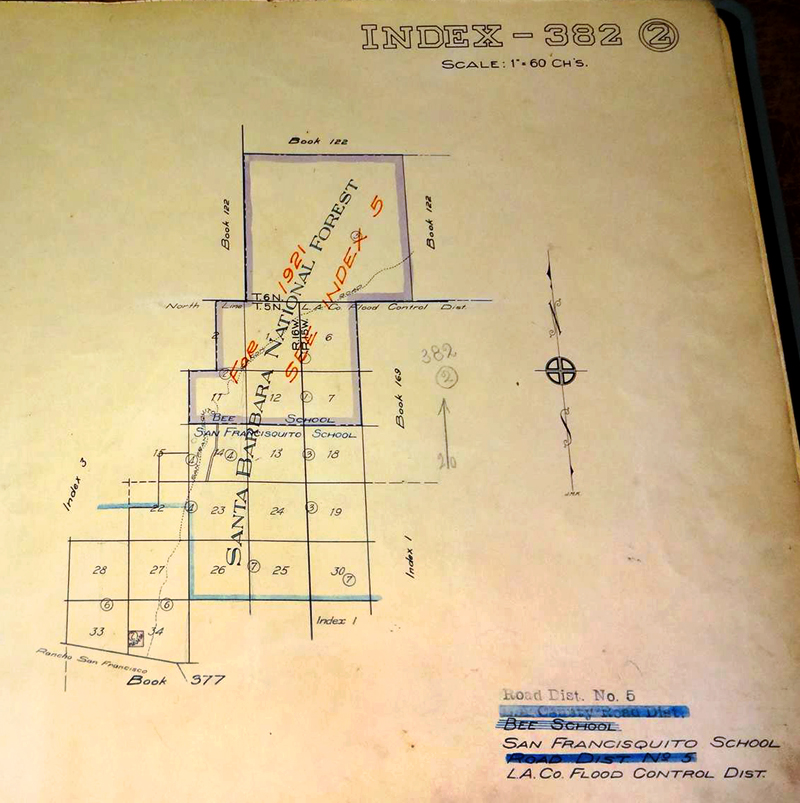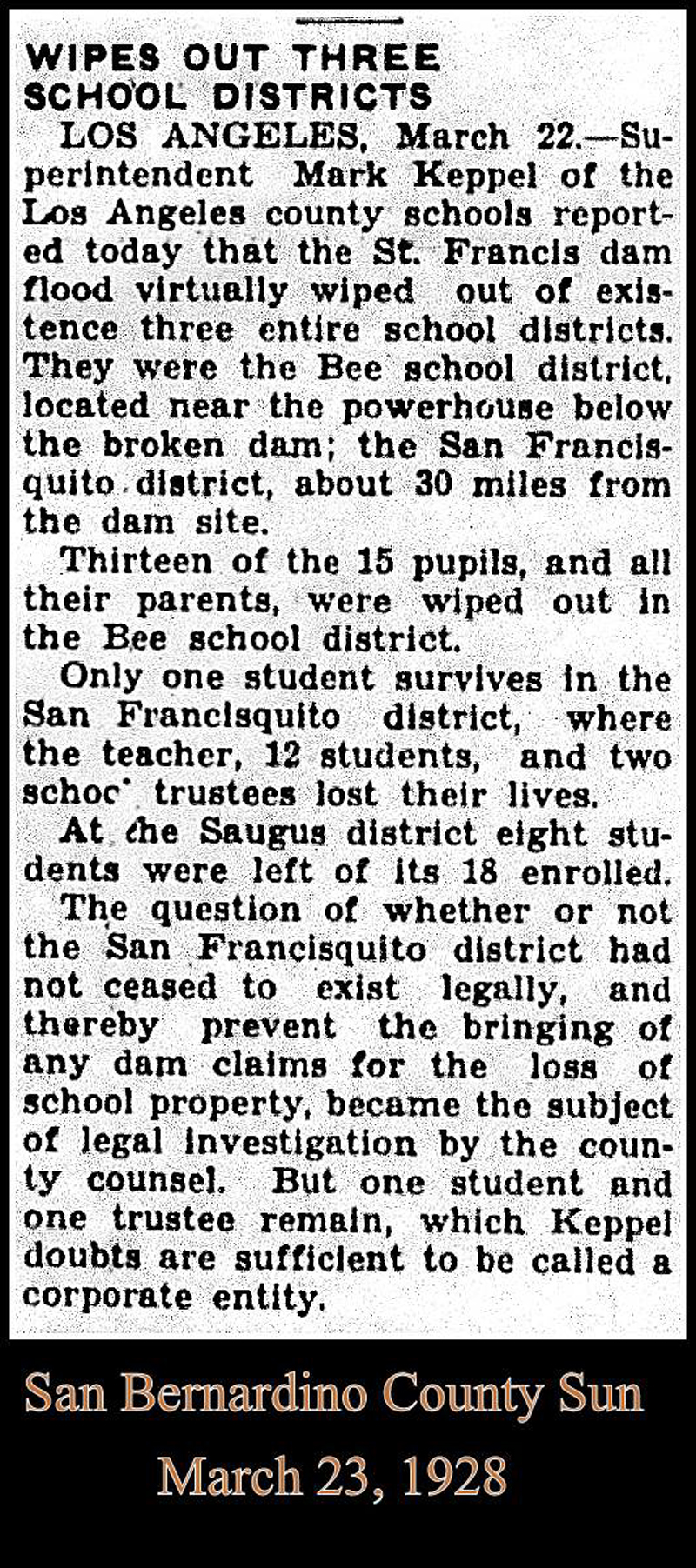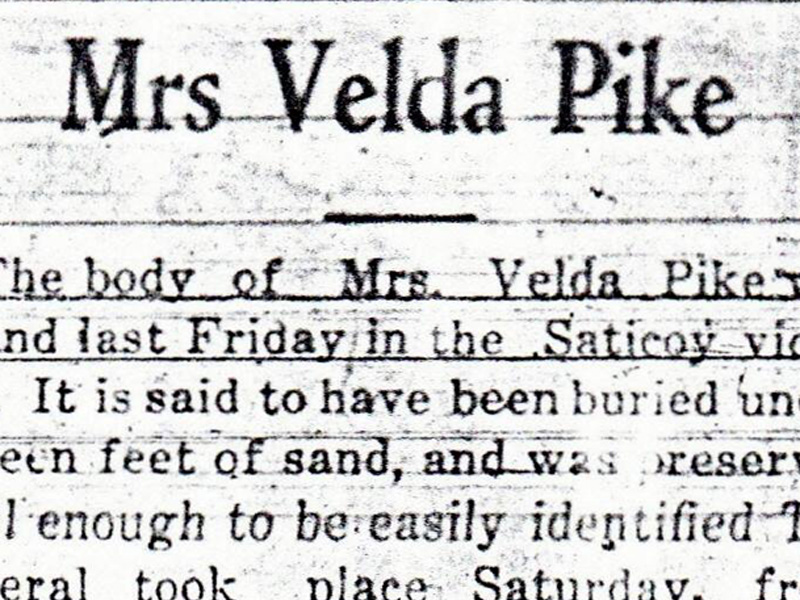|
|
San Francisquito Canyon

Click image to enlarge
The 3-year-old San Francisquito School was wiped from the face of the earth when the St. Francis Dam collapsed on the night of March 12, 1928. Today, few people know it existed at all, perhaps because eight of its 13 pupils (*see note below), and its teacher, and two of its three school board members, didn't live to tell about it.
This ghostly image of March 9, 1928 (see back), comes to us originally from Nelma Deem Campbell of Wellington, Nev., by way of dam historian Frank Rock. From the identifications on the back, we see Nelma and her three siblings in this photo — Harold, Mel and Charles. All four survived and grew up in San Francisquito Canyon. Another copy comes to us from from dam disaster researcher Ann Stansell, who obtained it from Carol Rising Longo. Her father, Ray Rising, was one of the few survivors among the community of 70 people — DWP workers and their families — who lived just to the west of Powerhouse No. 2. Ray floated to safety on a rooftop, but his wife and their three daughters were killed. Ray later remarried a woman named Ruby, and their child was Carol Sue Rising (Longo). Carol notes (2020): "I believe the little girl in the front with the bowl cut [far left] is one of my half-sisters, possibly Delores, and the woman behind her is Julia, my father's first wife." According to an article in the Los Angeles Herald newspaper, found by local historian Lauren Parker, the need for a school in San Francisquito was identified as early as May 1909 when construction was under way on the L.A. Aqueduct system's Elizabeth Tunnel. Its south portal opens onto upper San Francisquito Canyon. "South Portal, the closest point to Los Angeles on the aqueduct where heavy construction work is being done, has become a family camp," the article states, "and because of this fact a school and teacher are wanted at this point. J.B. Lippincott, aqueduct engineer, recommended to the board of public works yesterday that the board of education be asked to take the matter up with the county officials and secure and allotment for a school at this point in the next fiscal budget." The article implies that the area was under the jurisdiction of the county superintendent of schools. At some point the Bee School District was formed, and the Bee School was erected in Bee Canyon to serve DWP families where the Elizabeth Tunnel terminated in 1911 and Powerhouse No. 1 was being built. Powerhouse No. 1 was completed in 1917 (Outland 1977); apparently by the time Powerhouse No. 2 was operational in 1920 (ibid.), six miles down the canyon, the Bee School had moved to that location to service children in the Powerhouse No. 2 community. The school remained at that location until March 12, 1928.
A map provided by Parker shows a boundary line between the Bee School District and the jurisdiction of the San Francisquito School District on the south. Its school — the one pictured above — was probably located 3 to 4 miles south of the dam, on or near property owned by the Raggio family. Journalist Don Ray, who interviewed younger Raggio family members, reports that they remembered attending school in the canyon prior to the dam break. They did not recall its name, but Ray suspects it was the San Francisquito School. "They named three teachers," Ray writes: "Mrs. Small, whom they said was small in stature and wore glasses; Mrs. Potts, who lived in a small cabin on the Raggio Ranch property; and what sounded like Lorena Hinkhouse, who had a daughter." A Lorena S. Hinkhouse appears in city records as a teacher in Long Beach. "The Raggio brothers lived on the ranch on their grandfather's property, farther up the canyon," Ray writes. "They stayed in the family house in Los Angeles so they could attend Lincoln High School in the late '20s." Whichever schoolhouse it was, it was gone. According to an article Ray found in the San Bernardino County Sun of March 23, 1928, the Bee School District lost 13 of its 15 pupils; San Francisquito lost 12 of 13 [sic; 8 of 13]; and still farther south, the Saugus School District lost 10 of 18.
The body of Cecilia Small, the San Francisquito schoolteacher, was found March 16 in Newhall (see this document and this news report). The schoolhouse was pulverized. Parker provides the following entry from the Fillmore Herald of March 23, 1928: "A section of the San Francisquito school house, which was located well up the canyon, was found near the mouth of the Sespe. It was a section of the front elevation and still bore the date the building was erected, '1925,' and the name of the school." The Sespe River opens out west of Fillmore. (It should be noted that the children's deaths had nothing to do with the schools. Saying "8 of 13" is simply a mechanism for interpreting the magnitude of the disaster. It's not as if the children were in class when the dam broke at three minutes before midnight. Rather, they were in bed when their homes were destroyed.) Of the three schools, only the Saugus schoolhouse remained intact, although it, like the Bee, was completely rebuilt from 1936-1938. (Bee was reestablished in 1930 at a different location). Of the three schools, only the San Francisquito School never came back. Practically nobody was left to sue the city of Los Angeles — the owner of the dam — for damages to school property. At least, that's the conclusion evidently reached by Mark Keppel, Los Angeles County's superintendent of schools. "The question of whether or not the San Francisquito district had not ceased to exist legally, and thereby prevent the bringing of any dam claims for the loss of school property, became the subject of legal investigation by the county counsel," according to the March 23, 1928, news article. "(Only) one student and one trustee remain, which Keppel doubts are sufficient to be called a corporate entity." Note: It was long reported that 12 of the 13 pupils perished. The survival of the four Deem children doesn't compute.
FR2802a: 19200 dpi jpeg from early 8x10 print | Same as AS2801 |
ALSO SEE:
Background: Forgotten Casualties (CSUN 2013)
• Memorialization and Memory • Paper: Oral History (Licon 2014) Story: Victims & Heroes
FILM: Body Recovery, Newhall Morgue
FILM: Nighttime Recovery of Bodies
3-17-1928
Tony Harnischfeger
Lyman & Lillian Curtis
Marjorie & Mazie Curtis (Mult.)
San Francisquito School
Cecilia Small, Schoolteacher
Ruiz Family x7
Pete Rivera
Erratchuo 1928
1928 Mourners
Newhall Cowboys 1928 Marker x2
Newhall Morgue
Gottardi Family
Felda Pike Obituary
Saugus Community Club Members
Oral History: Thelma McCawley Shaw 2010
Oral History: Biz Basolo 2009
|
The site owner makes no assertions as to ownership of any original copyrights to digitized images. However, these images are intended for Personal or Research use only. Any other kind of use, including but not limited to commercial or scholarly publication in any medium or format, public exhibition, or use online or in a web site, may be subject to additional restrictions including but not limited to the copyrights held by parties other than the site owner. USERS ARE SOLELY RESPONSIBLE for determining the existence of such rights and for obtaining any permissions and/or paying associated fees necessary for the proposed use.






















